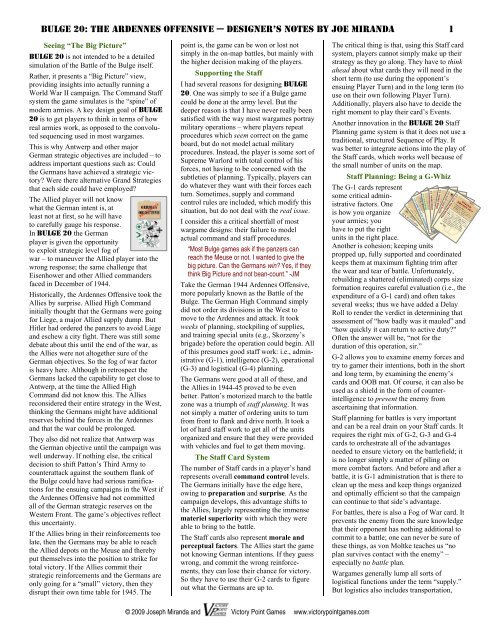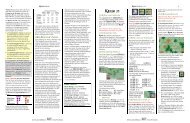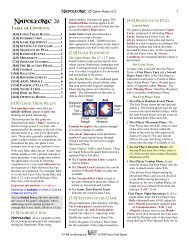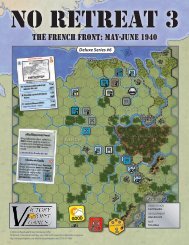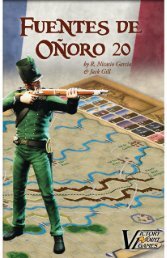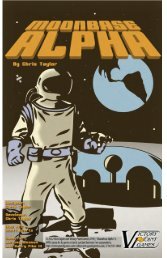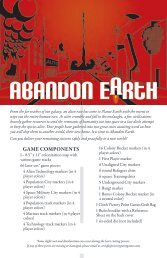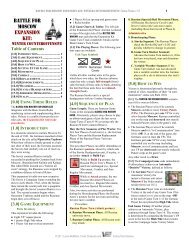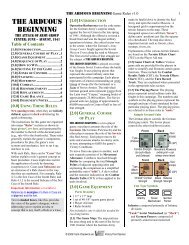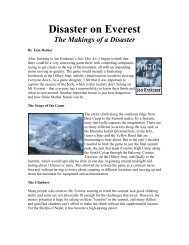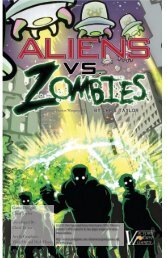Designer's notes by Joe Miranda 1 - Victory Point Games
Designer's notes by Joe Miranda 1 - Victory Point Games
Designer's notes by Joe Miranda 1 - Victory Point Games
- TAGS
- miranda
You also want an ePaper? Increase the reach of your titles
YUMPU automatically turns print PDFs into web optimized ePapers that Google loves.
Bulge 20: The Ardennes Offensive — Designer’s <strong>notes</strong> <strong>by</strong> <strong>Joe</strong> <strong>Miranda</strong> 2administration, medical and much more.With this game system, you can employ G-4cards to make your combat units moreeffective in movement and combat. G-4 cardscan also be used reconstitute shatteredformations that were in supply.The mix of G-type cards that both sides haveavailable to them in the game represents theoverall capabilities of each side. The Alliesget more G-4 cards (particularly the genericones), representing their massive superiorityin logistics – and the German deficiency inthis area. The Event cards represent one timemajor events, unique historical incidents, andhelp tell the “story” of the campaign.You will note that someGerman Staff cards canbe played only if theyhave chosen the WachtAm Rhein objective. Thiswas done mainly to givethe Germans a reason to choose their mostdifficult objective and reflects a “maximumeffort” potential to it. In other words, if theGermans wish to risk more, they get morewith which to execute it. The “Small Slam”objectives are balanced <strong>by</strong> these cards(representing extraordinary effort andcommitments) not being available.And allow me to interject a note about theweather, as it was critical to the battle; andnot simply because of the ability to utilizeairpower. Bad weather meant that it wasmore difficult to move men and suppliesalong the already overcrowded and decayingroad network, so if weather is clear bothplayers draw an extra Staff card to simulatethe improving conditions on the ground.Order of BattleThe game gives each playercommand responsibility at theArmy Group level. TheGerman front here was underModel’s Army Group B. The Allies werelargely under Omar Bradley’s 12th ArmyGroup. This Bulge game is unique in that itincludes The Big Picture, from the Westwallto Antwerp.It takes one Operations card to conductmovement or attack with one unit(regardless of its size). What thismeans is that it is more efficientto keep your corps together inarmies rather than dispersing them across themap as detachments. This game mechanicneatly simulates this command control issue.Of course, sometimes you will have to detachcorps, simply to cover more ground, or toexploit an opportunity – and it is those sortsof evolving dilemmas that make the puzzlesin life and games so interesting.Corps are essentially the “strength points”and “damage markers” that make up thearmies. Each corps represents three to fivedivisions. Allied corps are stronger due totheir generally superior combat experienceand firepower, as well as higher divisionalstrength. In some cases, I readjusted thenumber and type of corps to give the correctbalance of forces for better gameplay.For example, 1st SS Panzer corps includedtwo armored and three infantry divisions, so I“moved” a couple of the infantrydivisions to some of the understrengthGerman infantry corps tobalance things out. Overall, thenumbers total up correctly. On theAllied side, US armored corpsrepresent formations which hadeither additional armoreddivisions, or more aggressive leadership.Bear in mind that the US Army did not havean armored corps echelon; they are in thisgame to allow these units to represent afunctional distinction.The MapThe map is not a point-to-point system. Itrepresents what are termed the “main supplyroutes” (MSRs) and “axes of advance.”These are not necessarily identical to the roadnetwork but rather where both sides had theirlogistical nets set up for army levelformations. MSRs, <strong>by</strong> their very nature, aredifficult to shift about on the Army and ArmyGroup levels, especially in terrain like theArdennes, and especially in winter. Look athow the Sicilian campaign hinged on thepossession of a couple of key supply roads –and this was in summer without all the usualproblems of a winter campaign. Remember,you’re doing staff planning now!There is no cost in movement points to enterdifferent types of terrain. Movement costs areactually built into the number of spacesdesigned onto the game board. In theArdennes, there is a higher density of spaces,representing the difficulty of moving throughthe forests and ridges. Northwest of theMeuse River, the terrain opens up, so thereare fewer spaces; thus it is two spaces fromthe Meuse crossings to Antwerp and Brussels,compared to the three or four spaces ittakes to reach the Meuse via the Ardennes.Probably one of the most critical factors inthe Battle of the Bulge was traffic control.The Germans could not deploy their panzerformations because armored units werebunched up on the roads that deteriorated intomuddy quagmires. This is one reason that 6thPanzer Army attempted to use its infantrydivisions to make the initial breakthrough.This is also the reason that rough terrain andrivers restrict the number of attacking units.This forces players to make decisions aboutkeeping some of their corps in reserve thattheir historical counterparts had to face.Although it is largely because they could notbe used up front, it also was better to commitfresh units later when you could see which ofyour armies has made a breakthrough, if any.Note that you have to control a space to run aLOC through it. This represents setting upsupply routes, forward support points, etc.Historically, German spearheads facedconsiderable logistical shortfalls (and thushave a shorter LOC range in the game). Theproblem was not so much a lack of supply,but a lack of transport. They lacked thevehicles to move supplies, spare parts andreplacements forward – and even where theyhad sufficient transports, the a<strong>by</strong>smal roadsituation made such support problematic. Themassive Allied logistical “tail” proved itselfin this campaign, especially during the firstpart in which the Allies were falling back ontheir own lines of communications.Air OperationsThe Air rules owe a lot to Matt Caffrey’s“AirLand Battle of the Bulge” thesis. Hisresearch indicates that both sides actuallycommitted large numbers of aircraft to theBulge campaign, right from the start. This iscontrary to the usual view, which is that theweather kept the Air Forces from operatinguntil December 23rd or so. Actually, what theweather did was to restrict close air support.Throughout the campaign, the Allies madeconsiderable effortstowards interdictingGerman rear areatraffic, and attackingdepots. It also providedair cover against theLuftwaffe, which made this campaign its onelast great aerial offensive of the war.In the game, players cannot conduct close airsupport until the weather clears. Otherwise,their air force cards are useful in cuttingdown the efficiency of the enemy supportsystem <strong>by</strong> causing Staff card discards.The PresentationAlan Emrich came up with the graphic designfor BULGE 20 – trying to capture a WW2“war movie” Headquarters look and feel.Ably assisted <strong>by</strong> Tim Allen, this dynamic duohas greatly enhanced this board game’sverisimilitude and storytelling ability.And that, dear wargamer, is BULGE 20. It’ssomething of an experiment, in that I haveinvented the Command Staff game system tomake it work. And, if you like it, there aremany more wargames that can use this samesystem, and on different subjects and at largerscales. One possibility might be the Breakoutand Pursuit campaign in France following theNormandy landings and ending with Arnhem.The Allies would have to breach the Rhinebefore winter sets in. Or maybe the AmericanCivil War or Napoleonics? Wherever staffplanning can really shine, this system isdesigned to take wargamers there. – JM© 2009 Joseph <strong>Miranda</strong> and<strong>Victory</strong> <strong>Point</strong> <strong>Games</strong>www.victorypointgames.com


